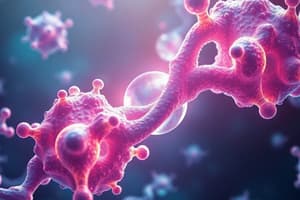Podcast
Questions and Answers
Match the following terms with their descriptions:
Match the following terms with their descriptions:
Enzymes = Proteins that act as biological catalysts by accelerating chemical reactions Substrates = Molecules upon which enzymes may act Products = Different molecules produced when enzymes convert substrates Ribozymes = Catalytic RNA molecules
Match the following statements with the correct features of enzymes:
Match the following statements with the correct features of enzymes:
Enzyme's specificity = Comes from its unique three-dimensional structure Enzyme's function = Increase the reaction rate by lowering activation energy Enzyme's consumption in chemical reactions = Not consumed in chemical reactions Enzyme's difference from most other catalysts = Much more specific
Match the following terms with their roles in enzymology:
Match the following terms with their roles in enzymology:
Enzymes = Biological catalysts for accelerating chemical reactions Pseudoenzymes = Lost the ability to carry out biological catalysis during evolution Biocatalysts = Catalytic RNA molecules Enzymology = The study of enzymes
Match the following examples with their characteristics:
Match the following examples with their characteristics:
Match the following statements with the correct information about enzyme catalysis:
Match the following statements with the correct information about enzyme catalysis:
Match the following terms with their descriptions:
Match the following terms with their descriptions:
Match the following enzyme characteristics with their descriptions:
Match the following enzyme characteristics with their descriptions:
Match the following statements about enzyme families with their explanations:
Match the following statements about enzyme families with their explanations:
Match the following characteristics of enzyme structures with their explanations:
Match the following characteristics of enzyme structures with their explanations:
Match the following enzyme mechanism terms with their descriptions:
Match the following enzyme mechanism terms with their descriptions:
Match the following enzyme discoveries with their respective scientists:
Match the following enzyme discoveries with their respective scientists:
Match the following enzyme properties with their effects on enzyme activity:
Match the following enzyme properties with their effects on enzyme activity:
Match the following enzyme classification methods with their descriptions:
Match the following enzyme classification methods with their descriptions:
Match the following commercial uses of enzymes with their applications:
Match the following commercial uses of enzymes with their applications:
Flashcards are hidden until you start studying
Study Notes
Enzyme Activity, Etymology, and Classification
- Enzyme activity can be affected by inhibitors and activators
- Therapeutic drugs and poisons can act as enzyme inhibitors
- Enzyme activity decreases significantly outside optimal temperature and pH
- Enzymes can be permanently denatured by excessive heat
- Some enzymes are used commercially, such as in the synthesis of antibiotics and household products
- French chemist Anselme Payen discovered the first enzyme, diastase, in 1833
- German physiologist Wilhelm Kühne first used the term "enzyme" in 1877
- Eduard Buchner discovered cell-free fermentation and received the Nobel Prize in Chemistry in 1907
- James B. Sumner showed that urease and catalase were pure proteins and crystallized them
- John Howard Northrop and Wendell Meredith Stanley demonstrated that pure proteins can be enzymes
- The structure of lysozyme was solved by x-ray crystallography in 1965, marking the beginning of structural biology
- Enzymes can be classified by amino acid sequence similarity or enzymatic activity, with names often derived from their substrate or catalyzed reaction
Studying That Suits You
Use AI to generate personalized quizzes and flashcards to suit your learning preferences.




